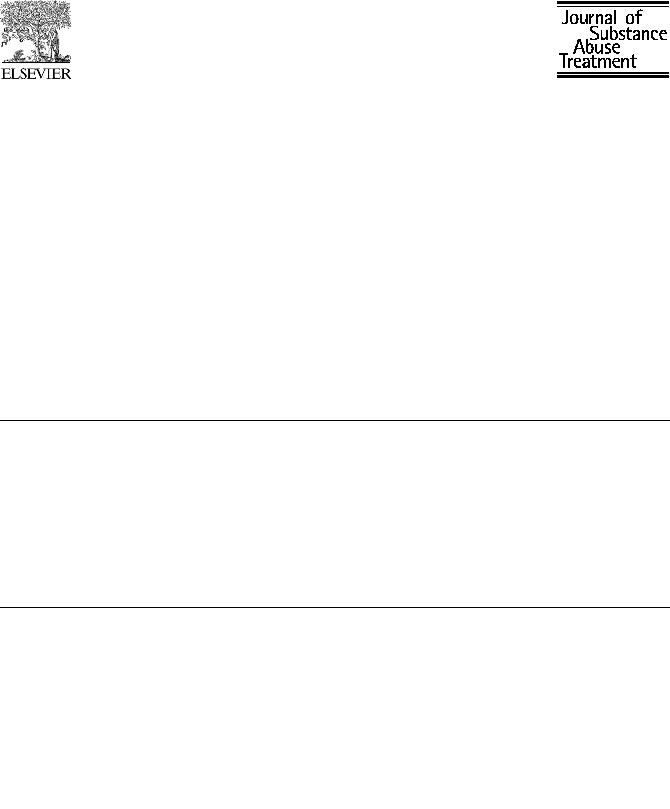happen) and the nonoccurrence (what did not but should have happened) of therapeutic interventions; and it presented a lesser burden to code. All told, our recommendation for fidelity evaluation in field settings—and even in research settings when therapist competence is not the main focus—is the following: Assess adherence to the main therapeutic goals individually, but assess competence as one global dimension.
The next step in developing the TBRS-C is refining the item descriptions and scoring procedures for therapist competence to enhance their reliability. It is possible that interrater reliability would be stronger if the instrument were used with community therapists in routine clinical practice, who might be expected to show significantly greater variability in general therapy skills and in fidelity to manualized treatments. Another important step in examining the psychometric properties of the TBRS-C is predictive validity analyses: Do adherence and competence in treatment goals predict outcome? Previous studies on the same research sample showed that adherence to discrete intervention techniques was linked to adolescent outcomes in both treatments (Hogue, Dauber, Samuolis, & Liddle, 2006; Hogue, Liddle, Dauber, & Samuolis, 2004). The TBRS-C can also be used to track changes in model fidelity in the course of training a specific cohort of therapists (e.g., Crits- Christoph et al., 1998), replicating and adapting a given model in various clinical settings (Mowbray, Holter, Teague, & Bybee, 2003), or operationalizing therapy change processes in research on mechanisms of behavioral change (Doss, 2004). But clearly, the broadest potential value of the TBRS-C lies in adapting the instrument to measure adherence/competence for other evidence-based practices in everyday care for a wide variety of mental health disorders.
Acknowledgments
Preparation of this article was supported by grants R01 DA14571 (principal investigator: A. Hogue) and P50 DA07697 (principal investigator: H. Liddle) from the National Institute on Drug Abuse. The authors are extremely grateful to both teams of TBRS-C coders: for MDFT, Laura Alvarez-Cienfuegos, Mary Ekwall, Maria Dolores Fatas, Karly Gilbert, Oscar Ocasio, Lisette Sanabria-Velasquez, and Miguel Vilaro-Colon from the Roberto Clemente Family Guidance Center, along with Priscilla Chinchilla; for CBT, Jayme Albin, Peter Berzins, Roland Carstedt, Sue Manin, Leslie Sadoff, and Robert Udewitz from Behavioral Associates, along with Adam Fried. The authors thank Leyla Stambaugh, Leslie Alkalay, and Crystall Matthews for research contributions to this study, and Gayle Dakof and Cindy Rowe for providing feedback on the manuscript.
References
Barber, J. P., & Crits-Christoph, P. (1996). Development of a therapist adherence/competence rating scale for supportive–expressive dynamic psychotherapy: A preliminary report. Psychotherapy Research, 6, 81-94.
Barber, J. P., Crits-Christoph, P., & Luborsky, L. (1996). Effects of therapist adherence and competence on patient outcome in brief dynamic therapy. Journal of Consulting and Clinical Psychology, 64, 619-622.
Barber, J. P., Foltz, C., Crits-Christoph, P., & Chittams, J. (2004). Therapists' adherence and competence and treatment discrimination in the NIDA Collaborative Cocaine Treatment Study. Journal of Clinical Psychology, 60, 29-41.
Barber, J. P., Gallop, R., Crits-Christoph, P., Frank, A., Thase, M. E., Weiss, R. D., et al. (2006). The role of therapist adherence, therapist competence, and alliance in perdicting outcome of individual drug counseling: Results from the National Institute on Drug Abuse Collaborative Cocaine Treatment Study. Psychotherapy Research, 16, 229-240.
Barber, J. P., Liese, B. S., & Abrams, M. J. (2003). Development of the Cognitive Therapy Adherence and Competence Scale. Psychotherapy Research, 13, 205-221.
Carroll, K. M., Connors, G. J., Cooney, N. L., DiClemente, C. C., Donovan, D. M., Kadden, R. R., et al. (1998). Internal validity of Project MATCH treatments: Discriminability and integrity. Journal of Consulting and Clinical Psychology, 66, 290-303.
Carroll, K. M., Nich, C., & Rounsaville, B. J. (1998). Utility of therapist session checklists to monitor delivery of coping skills treatment for cocaine abusers. Psychotherapy Research, 8, 307-320.
Carroll, K. M., Nich, C., Sifry, R. L., Nuro, K. F., Frankforter, T. L., Ball, S. A., et al. (2000). A general system for evaluating therapist adherence and competence in psychotherapy research in the addictions. Drug and Alcohol Dependence, 57, 225-238.
Cicchetti, D. V. (1994). Guidelines, criteria, and rules of thumb for evaluating normed and standardized assessment instruments in psychol- ogy. Psychological Assessment, 6, 284-290.
Crits-Christoph, P., Siqueland, L., Chittams, J., Barber, J. P., Beck, A. T., Frank, A., et al. (1998). Training in cognitive, supportive–expressive, and drug counseling therapies for cocaine dependence. Journal of Consulting and Clinical Psychology, 66, 484-492.
Diamond, G. M., Liddle, H. A., Hogue, A., & Dakof, G. A. (1999). Alliance- building interventions with adolescents in family therapy: A process study. Psychotherapy: Theory Research, Practice, & Training, 36, 355-368.
Diamond, G. S., & Diamond, G. M. (2002). Studying a matrix of change mechanisms: An agenda for family-based process research. In H. A. Liddle, D. A. Santisteban, R. F. Levant, & J. H. Bray (Eds.), Family psychology: Science-based interventions (pp. 41-46). Washington, DC: American Psychological Association: American Psychological Association.
Dobson, K. S., & Shaw, B. F. (1993). The training of cognitive therapists: What have we learned from treatment manuals? Psychotherapy: Theory Research, Practice, & Training, 30, 573-577.
Doss, B. D. (2004). Changing the way we study change in psychotherapy.
Clinical Psychology: Science and Practice, 11, 368-386.
Elkin, I. (1999). A major dilemma in psychotherapy outcome research: Disentangling therapists from therapies. Clinical Psychology: Science and Practice, 6, 10-32.
Fleiss, J. L. (1981). Balanced incomplete block designs for inter-rater reliability studies. Applied Psychological Measurement, 5, 105-112.
Garland, A. F., Hurlburt, M. S., & Hawley, K. M. (2006). Examining psychotherapy processes in a services research context. Clinical Psychology: Science and Practice, 13, 30-46.
Hartley, D. E., & Strupp, H. H. (1983). The therapeutic alliance: Its relationship to outcome in brief psychotherapy. In J. Masling (Ed.),
Empirical studies of psychoanalytical theories, Vol. 1 Hillsdale, NJ: Analytical Press: Analytical Press.
Hayes, S. C., Barlow, D. H., & Nelson-Gray, R. O. (1999). The scientist– practitioner: Research and accountability in the age of managed care. New York: Allyn & Bacon.
Henderson, C. E., Young, D. W., Jainchill, N., Hawke, J., Farkas, S., & Davis, R. M. (2007). Program use of effective drug abuse treatment


